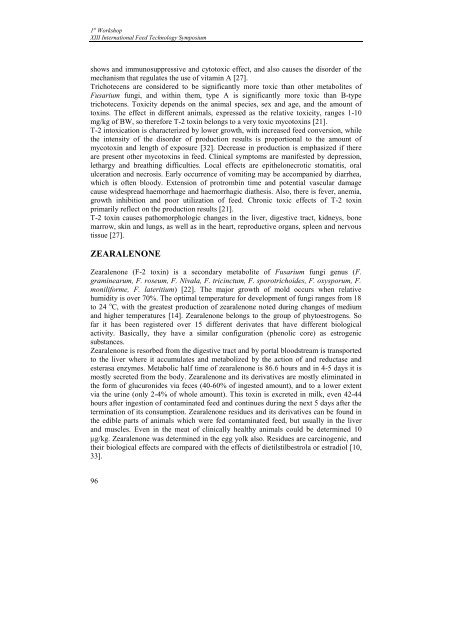Effects of dietary n-3 polyunsaturated fatty acids and ... - FINS
Effects of dietary n-3 polyunsaturated fatty acids and ... - FINS
Effects of dietary n-3 polyunsaturated fatty acids and ... - FINS
You also want an ePaper? Increase the reach of your titles
YUMPU automatically turns print PDFs into web optimized ePapers that Google loves.
1 st WorkshopXIII International Feed Technology Symposiumshows <strong>and</strong> immunosuppressive <strong>and</strong> cytotoxic effect, <strong>and</strong> also causes the disorder <strong>of</strong> themechanism that regulates the use <strong>of</strong> vitamin A [27].Trichotecens are considered to be significantly more toxic than other metabolites <strong>of</strong>Fusarium fungi, <strong>and</strong> within them, type A is significantly more toxic than B-typetrichotecens. Toxicity depends on the animal species, sex <strong>and</strong> age, <strong>and</strong> the amount <strong>of</strong>toxins. The effect in different animals, expressed as the relative toxicity, ranges 1-10mg/kg <strong>of</strong> BW, so therefore T-2 toxin belongs to a very toxic mycotoxins [21].T-2 intoxication is characterized by lower growth, with increased feed conversion, whilethe intensity <strong>of</strong> the disorder <strong>of</strong> production results is proportional to the amount <strong>of</strong>mycotoxin <strong>and</strong> length <strong>of</strong> exposure [32]. Decrease in production is emphasized if thereare present other mycotoxins in feed. Clinical symptoms are manifested by depression,lethargy <strong>and</strong> breathing difficulties. Local effects are epithelonecrotic stomatitis, oralulceration <strong>and</strong> necrosis. Early occurrence <strong>of</strong> vomiting may be accompanied by diarrhea,which is <strong>of</strong>ten bloody. Extension <strong>of</strong> protrombin time <strong>and</strong> potential vascular damagecause widespread haemorrhage <strong>and</strong> haemorrhagic diathesis. Also, there is fever, anemia,growth inhibition <strong>and</strong> poor utilization <strong>of</strong> feed. Chronic toxic effects <strong>of</strong> T-2 toxinprimarily reflect on the production results [21].T-2 toxin causes pathomorphologic changes in the liver, digestive tract, kidneys, bonemarrow, skin <strong>and</strong> lungs, as well as in the heart, reproductive organs, spleen <strong>and</strong> nervoustissue [27].ZEARALENONEZearalenone (F-2 toxin) is a secondary metabolite <strong>of</strong> Fusarium fungi genus (F.graminearum, F. roseum, F. Nivala, F. tricinctum, F. sporotrichoides, F. oxysporum, F.moniliforme, F. lateritium) [22]. The major growth <strong>of</strong> mold occurs when relativehumidity is over 70%. The optimal temperature for development <strong>of</strong> fungi ranges from 18to 24 o C, with the greatest production <strong>of</strong> zearalenone noted during changes <strong>of</strong> medium<strong>and</strong> higher temperatures [14]. Zearalenone belongs to the group <strong>of</strong> phytoestrogens. S<strong>of</strong>ar it has been registered over 15 different derivates that have different biologicalactivity. Basically, they have a similar configuration (phenolic core) as estrogenicsubstances.Zearalenone is resorbed from the digestive tract <strong>and</strong> by portal bloodstream is transportedto the liver where it accumulates <strong>and</strong> metabolized by the action <strong>of</strong> <strong>and</strong> reductase <strong>and</strong>esterasa enzymes. Metabolic half time <strong>of</strong> zearalenone is 86.6 hours <strong>and</strong> in 4-5 days it ismostly secreted from the body. Zearalenone <strong>and</strong> its derivatives are mostly eliminated inthe form <strong>of</strong> glucuronides via feces (40-60% <strong>of</strong> ingested amount), <strong>and</strong> to a lower extentvia the urine (only 2-4% <strong>of</strong> whole amount). This toxin is excreted in milk, even 42-44hours after ingestion <strong>of</strong> contaminated feed <strong>and</strong> continues during the next 5 days after thetermination <strong>of</strong> its consumption. Zearalenone residues <strong>and</strong> its derivatives can be found inthe edible parts <strong>of</strong> animals which were fed contaminated feed, but usually in the liver<strong>and</strong> muscles. Even in the meat <strong>of</strong> clinically healthy animals could be determined 10g/kg. Zearalenone was determined in the egg yolk also. Residues are carcinogenic, <strong>and</strong>their biological effects are compared with the effects <strong>of</strong> dietilstilbestrola or estradiol [10,33].96
















